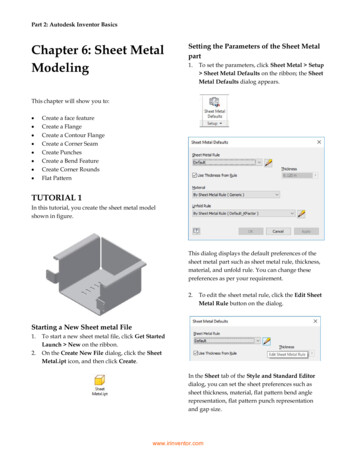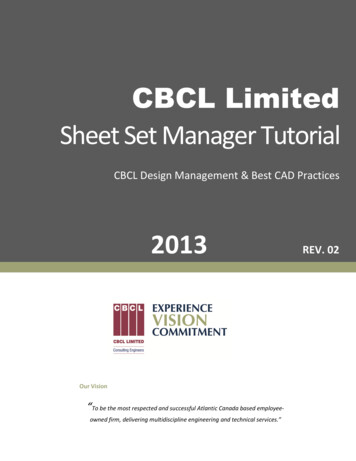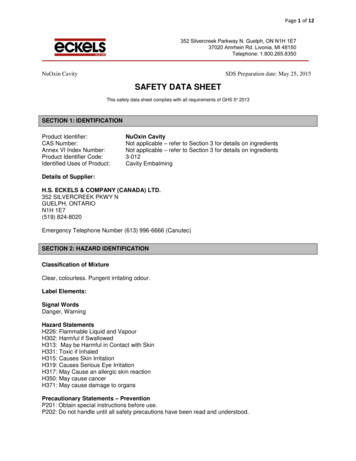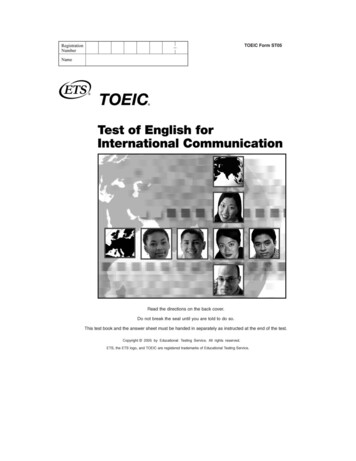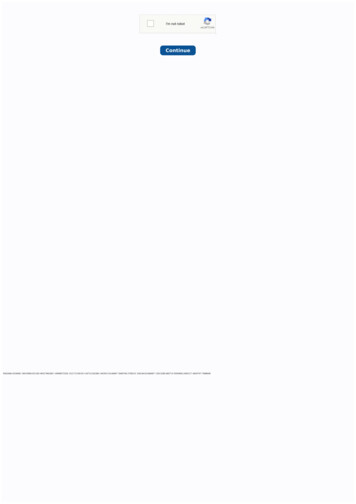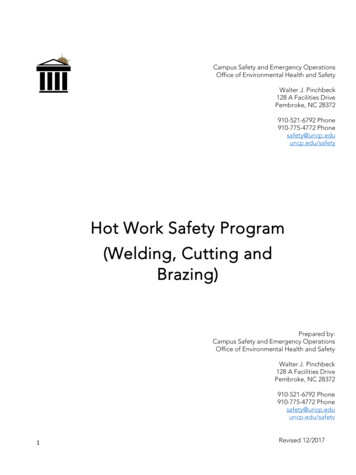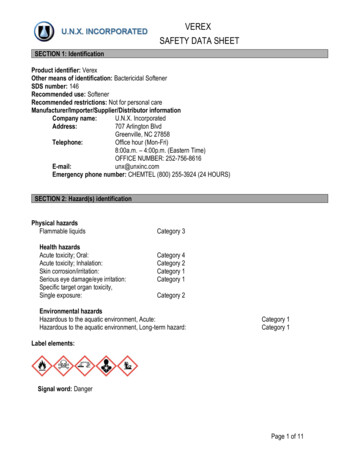
Transcription
VEREXSAFETY DATA SHEETSECTION 1: IdentificationProduct identifier: VerexOther means of identification: Bactericidal SoftenerSDS number: 146Recommended use: SoftenerRecommended restrictions: Not for personal careManufacturer/Importer/Supplier/Distributor informationCompany name:U.N.X. IncorporatedAddress:707 Arlington BlvdGreenville, NC 27858Telephone:Office hour (Mon-Fri)8:00a.m. – 4:00p.m. (Eastern Time)OFFICE NUMBER: 252-756-8616E-mail:unx@unxinc.comEmergency phone number: CHEMTEL (800) 255-3924 (24 HOURS)SECTION 2: Hazard(s) identificationPhysical hazardsFlammable liquidsHealth hazardsAcute toxicity; Oral:Acute toxicity; Inhalation:Skin corrosion/irritation:Serious eye damage/eye irritation:Specific target organ toxicity,Single exposure:Category 3Category 4Category 2Category 1Category 1Category 2Environmental hazardsHazardous to the aquatic environment, Acute:Hazardous to the aquatic environment, Long-term hazard:Category 1Category 1Label elements:Signal word: DangerPage 1 of 11
SECTION 2: Hazard(s) identification (continued)Hazard e liquid and vapor.Toxic if swallowed.Causes severe skin burns and eye damage.Causes serious eye damage.Fatal if inhaled.May cause damage to organs.Very toxic to aquatic life.Very toxic to aquatic life with long lasting effects.Precautionary statementsPreventionP101If medical advice is needed, have product container or label at hand.P102Keep out of reach of children.P103Read label before use.P210Keep away from heat/sparks/open flames/hot surfaces. No smoking.P233Keep container tightly closed.P240Ground/bond container and receiving equipment.P241Use explosion-proof electrical/ventilating/lighting/ /equipment.P242Use only non-sparking tools.P243Take precautionary measures against static discharge.P260Do not breathe mist or vapor.P264Wash hands, arms, face and exposed skin thoroughly after handling.P270Do not eat, drink or smoke when using this products.P271Use only outdoors or in a well-ventilated area.P273Avoid release to the environment.P280Wear protective gloves/protective clothing/eye protection/face protection.P284[In case of inadequate ventilation] wear respiratory protection.Response:P301 330 331P303 361 353P304 P340P305 P351 P338P362 P364Storage:P403 223P403 235P405Disposal:P501IF SWALLOWED: Immediately a POISON CENTER or doctor/physician if you feelunwell. Rinse mouth. Do NOT induce vomiting.IF ON SKIN (or hair): Take off immediately all contaminated clothing. Rinse skinwith water/shower.IF INHALED: Remove person to fresh air and keep comfortable for breathing.IF IN EYES: Rinse cautiously with water for several minutes. Remove contactlenses, if present and easy to do. Continue rinsing.Take off contaminated clothing and wash it before reuse.Store in a well-ventilated place. Keep container tightly closed.Store in a well-ventilated place. Keep cool.Store locked up.Dispose of contents/container in accordance with local/ regional/ national/international Regulations.Hazard(s) not otherwise classified (HNOC)None known.Page 2 of 11
SECTION 3: Composition/information on ingredientsSubstance/MixturesChemical nameWaterMethyl-1-tallow amidoethyl-2-tallow imidazoliniumAlkyl dimethyl benzyl ammonium chloride (C12-18)Alkyl dimethyl ethylbenzyl ammonium chloride (68% C12, 32% C14)Propan-2-olEthanolCAS -064-17-5Concentration (%)65-805-155-155-150-100-5SECTION 4: First-aid measuresDescription of first aid measuresGeneral advice: Remove victims from the danger zone without endangering your own safety. Removecontaminated clothing (including underwear and shoes) immediately.Inhalation: Move person to fresh air. If person is not breathing, call 911 or an ambulance then give artificialrespiration, preferably by mouth-to-mouth, if possible. Call a poison control center or doctor for furthertreatment advice.Skin contact: Take off contaminated clothing. Rinse skin immediately with plenty of water for 15-20minutes. Call a poison control center or doctor for treatment advice.Eye contact: Hold eye open and rinse slowly and gently with water for 15-20 minutes. Remove contactlenses, if present, after the first 5 minutes, then continue rinsing eye. Call a poison control center or doctorfor treatment advice.Ingestion: Call a poison control center or doctor immediately for treatment advice. Have person sip a glassof water if able to swallow. Do not induce vomiting unless told to do so by the poison control center ordoctor. Do not give anything by mouth to an unconscious person.Most important symptoms/effects, acute and delayed:Notes to physician: The severity of the symptoms described will vary dependent on the concentration andthe length of exposure.Inhalation: Irritation of nose, throat and airway.Ingestion: May cause nausea and/or vomiting. Irritation of the mouth, throat, esophagus andgastrointestinal tract.Skin contact/Skin irritation: Redness or rash may occur.Eye contact: Causes irritation and burns of the eyes. Possible corneal damage. May causeconjunctivitis Lachrymation.Indication of immediate medical attention and special treatment needed, if necessary:Cases of eye contact and ingestion should be treated immediately. Have facilities in place to wash skin andeyes in case of exposure.Page 3 of 11
SECTION 5: Fire-fighting measuresSuitable extinguishing media: Water fog, foam, dry chemical powder, or carbon dioxide (CO2).Unsuitable extinguishing media: Do not use water jet as this can spread the fire. Do not use carbondioxide in enclosed spaces with insufficient ventilation.Specific hazards arising from the chemical: Vapors may form explosive mixtures with air. Vapors maytravel considerable distance to a source of ignition and flash back. During fire, gases hazardous to healthmay be formed. Product containers can melt in the heat of a fire. Packaging materials will be combustibleand provide fuel for the fire. In the event of fire and/or explosion do not breathe fumes.Special protective equipment and precautions for fire-fighters: In the event of a fire, wear fullprotective clothing and NIOSH-approved self-contained breathing apparatus with full face piece operated inthe pressure demand or other positive pressure mode. During fire-fighting respirator with independent airsupply and airtight garment is required. Fight fire in early stages if safe to do so. Containers at risk of fireshould be cooled with water and, if possible removed from the danger area. Do not allow contaminatedextinguishing water to enter the soil, ground-water or surface waters.SECTION 6: Accidental release measuresPersonal precautions, protective equipment and emergency procedures: Ventilate area of leak orspill. Ensure adequate ventilation/exhaust extraction. Put on protective equipment (see Section 8). Haveemergency procedures in place for treating spillages, evacuating the area and informing the emergencyservices if necessary. Restrict access to the area until the spillage is treated, if large amounts of vapors areproduced that will be hazardous to others, evacuate the area. When any other effects of spillages will affectthe safety of others the area should be evacuated. Avoid ingestion, inhalation of vapors and contact withskin and eyes. Non-emergency personnel should be kept away from the area of spillage.Environment precautions: Do not flush into surface water or sanitary sewers system. Avoid unauthorizeddischarge to the environment. Clean up any spillages immediately; prevent material from spreading andentering drains or sewage systems. Large spillages or uncontrolled discharge to water systems must bealerted to the Environmental Agency or other regulatory body. If spillages to land cannot be treated safelyor if contamination will occur the Environment Agency must be alerted immediately. If the product hasentered a foul drain or sewage system in significant amounts to cause a hazard then the local watertreatment company must be informed.Methods and materials for containment and cleaning up: Contain and recover liquid when possible.Small spillages should be absorbed with an inert, non-combustible absorbent. Large Spillages: Dam andabsorb spillages with sand, earth or other inert material. Small quantities can be wiped up with absorbentmaterial (e.g. cloth, fleece.) Fit drain covers where they are available if the spillage is likely to enter thedrainage system. Collect spillage in containers, seal securely and deliver for disposal according to localregulations. Containers with collected spillage must be properly labeled with correct contents and hazardsymbol. Flush area clean with lots of water. Be aware of potential for surfaces to become slippery. Ventilatearea and allow drying before allowing access. Wash thoroughly after dealing with a spillage.Reference to other sections: Refer to sections 8 and 13 for additional information.Page 4 of 11
SECTION 7: Handling and storagePrecautions for safe handling: Keep in a tightly closed container and protect from physical damage.Store in a cool, dry, and ventilated area. Keep away from sources of heat, moisture, incompatibilities, andaway from direct sunlight. Do not mix with incompatible substances or mixtures. Avoid spilling the product.Do not wash out container and use it for other purposes. Avoid ingestion of the product, inhalation of anyvapors/mists when produced and contact with skin and eyes. Do not eat, drink or smoke when handling.Wash at the end of each work shift, before eating, drinking, smoking and using the toilet. Removecontaminated clothing/footwear/equipment before entering eating areas or places that would expose othersto the product. Do not use in areas close to drainage systems unless measures are in place to preventaccess of product. Ensure emergency procedures are in place to treat spillages and cope with othersituations such as evacuation. Provide eye washing and skin washing facilities, when handling largeamounts a safety shower is recommended. Observe all warnings and precautions listed for the product.Conditions for safe storage, including any incompatibilities: Store in closed original container attemperatures between 40 F and 80 F. If the product is transferred to another container, this should bemade of a compatible material to the original container. Store away from heat, direct sunlight and moisture.Store in a stable situation to avoid spillages. It is advisable to store in a bunded area or use other protectivemeasures such as a sump pallet or storage tray.SECTION 8: Exposure control/personal protectionControl ParametersOccupational exposure limitsUS.OSHA Table Z-1 Limits for Air Contaminants (29 CFR 1910.1000)Chemical NameCAS-No.TypeValueEthanol64-17-5PEL1,000 ppm1,900 mg/m3Propan-2-ol67-63-0PEL400 ppm980 mg/m3U.S. ACGIH Threshold Limit ValuesChemical LSTELTWAU.S. NIOSH Pocket Guide to Chemical Hazards ComponentsChemical 63-0TWAValue1,000 ppm400 ppm200 ppmValue1,000 ppm1,900 mg/m3500 ppm1225 mg/m3400 ppm980 mg/m3Page 5 of 11
SECTION 8: Exposure control/personal protection (continued)Appropriate engineering controls:Ventilation System:A system of local and/or general exhaust is recommended to keep employee exposures below thedefined exposure limit requirements or guidelines. Local exhaust ventilation is generally preferredbecause it can control the emissions of the contaminant at its source, preventing dispersion of it into thegeneral work area. Please refer to the ACGIH document, Industrial Ventilation, A Manual ofRecommended Practices, most recent edition for details.Individual protection measures, such as personal protective equipment (PPE)Eye Protection: Use chemical safety goggles and/or full face shield where dusting or splashing ofsolutions is possible. Maintain eye wash fountain and quick-drench facilities in work area.Skin Protection: Wear impervious protective clothing, including boots, gloves, lab coat, apron orcoveralls, as appropriate, to prevent skin contact.Hand protection: Wear protective gloves. Butyl rubber, rubber (natural, latex), nitrile, polyvinylchloride (PVC). Be aware that latex gloves can produce an allergic reaction in sensitive individuals.Gloves should have a breakthrough time sufficient for the amount of handling but allow dexterity for safemovement and handling. The most suitable glove must be chosen in consultation with the glovessupplier, who can inform about the breakthrough time of the glove material. Gloves showing signs ofdegradation should be changed to avoid skin contamination. Be aware that the liquid may penetrate thegloves. Frequent change is advisable. When removing used gloves apply proper technique by avoidingskin contact with the outer surface. When packages of the product are being handled during storage ortransport it is advisable to wear protective gloves to prevent damage to the skin.Personal Respirators (NIOSH Approved): If the exposure limit is exceeded, a full face piece respiratorwith high efficiency dust/mist filter may be worn up to 50 times the exposure limit. Wear suitablerespiratory protection when vapors or mists are produced if the Workplace Exposure Limit is exceededand there is insufficient ventilation or extraction. For emergencies or instances where the exposurelevels are not known, use a full face piece positive-pressure, air-supplied respirator. Respirator must befitted with a cartridge suitable for the chemical of concern. Consult with the supplier as to thecompatibility of the equipment with the chemical of concern. CAUTION: Air purifying respirators do notprotect the user in oxygen deficient atmospheres, use air supplied system.Thermal Hazards: Wear appropriate thermal protective clothing, when necessary.General hygiene considerations: Wash hands, change out of clothes as soon as possible.Wash clothes. Shower or bathe as soon as possible.Other protective measures: Have an eye bath and safety shower close by.SECTION 9: Physical and chemical propertiesAppearance:Colour:Odour:Odour Threshold:pH:Melting point/range:Boiling point/range:LiquidCreamy liquidNo odourNo data available4.5 0.5No data availableNo data availablePage 6 of 11
SECTION 9: Physical and chemical properties (continued)Flash point:No data availableEvaporation rate:No data availableFlammability (solid, gas):No data availableUpper/lower flammability of explosive limits: No data availableVapour pressure (mm Hg):No data availableVapour density (Air 1):No data availableRelative density:No data availableSolubility(ies):Excellent in warm waterPartition coefficient (n-octanol/water): No data availableAuto-ignition temperature:No data availableDecomposition temperature: No data availableViscosity, dynamic:25Other Information: This product contains no phosphates.SECTION 10: Stability and reactivityReactivity and/or chemical stability: No specific reactivity hazards associated with this product. Productis stable under normal conditions of use, storage and transport.Possibility of hazardous reactions: No dangerous reaction known under conditions of normal use.Conditions to avoid: Avoid heat, direct sunlight, open flames, and ignition sources. Avoid storage withincompatible materials. Avoid storage in freezing conditions. Avoid storage near to unprotected drainagesystems. It is advisable to store the product within some form of containment to prevent spillages reachingdrainage systems. Do not allow the storage container to be left exposed to the atmosphere. Avoid storagein an unstable manner or in a situation that would result in exposure to the product.Incompatible Materials: Strong oxidizing agents and anionic surfactants.Hazardous Decomposition Products: Upon decomposition this product may yield oxides of nitrogen andammonia, carbon dioxide, carbon monoxide and other low weight molecular hydrocarbons.SECTION 11: Toxicological informationAcute toxicity: Toxicological testing has not been conducted with this material. The toxicology informationlisted below is based on the components of this material.Category 4- OralHarmful if swallowed.Category 2- Inhalation Fatal if inhaled.Mixture of ADBAC/ADEBAC* – ATE (Acute Toxicity Estimate)Oral LD50Inhalation LC50Dermal LD50344 mg/kg (Rat)0.054 – 0.51 mg/L 2000 mg/kg (Rabbit)*Alkyl dimethyl benzyl ammonium chlorides / Alkyl dimethyl ethylbenzyl ammonium chloridesPage 7 of 11
SECTION 11: Toxicological information (continued)EthanolA3 Confirmed animal carcinogen with unknown relevance to humans.Skin Corrosion/ irritation: Category 1: Causes severe skin burns and eye damage.Serious eye damage/irritation: Category 1: Causes serious eye damage.Respiratory sensitization: No information available.Skin sensitization: This mixture not expected to cause skin sensitization.Germ cell mutagenicity: Classification not possible.Carcinogenicity: No product components are considered to be a carcinogen by IARC, ACGIH, NTP, orOSHA.Reproductive toxicity: This product is not expected to cause reproductive or developmental effects.Specific Target Organ Toxicity - Single Exposure: May cause damage to organs.Aspiration hazard: Not applicable.Specific Target Organ Toxicity - Single Exposure: Classification not possible.Aspiration hazard: Classification not possible.SECTION 12: Ecological informationToxicity: Do not allow to escape into waterways, wastewater or soil. Ecotoxicological studies of theproduct are not available. Please find below the data available to us from raw materials:Aquatic ecotoxicityAcute: Category 1: Very toxic to aquatic life.Chronic: Category 1: Very toxic to aquatic life with long lasting effects.Methyl-1-tallow amidoethyl-2-tallow imidazolinium Me sulfatesLC50 Fish65 ppm 96 hrsEC50 Algae0.063 mg/L 96 hMixture of ADBAC/ADEBAC*LC50 Daphnia0.0058 – 0.016 mg/L 48 hPropan-2-olLC50 Bluegill 1,400 mg/L 96 hrsLC50 Fish0.86 ppm 96 h*Alkyl dimethyl benzyl ammonium chlorides / Alkyl dimethyl ethylbenzyl ammonium chloridesPage 8 of 11
SECTION 12: Ecological information (continued)Persistence and degradability: No data is available on the degradability of this product.Bioaccumulative potential: No data available for this product.Mobility in soil: No data available.Other adverse effects: No other adverse environmental effects (e.g. ozone depletion, photochemicalozone creation potential, endocrine disruption, global warming potential) are expected from this component.SECTION 13: Disposal considerationsGeneral informationDo not allow unauthorized disposal to the environment. If operators are exposed to vapors during thedisposal process then suitable respiratory protection should be worn. All other personal protectiveequipment as described in section 8 should be worn.Disposal methods:Avoid unauthorized disposal. Do not dump into any sewers, on the ground, or into any body of water. Alldisposal practices must be in compliance with federal, state/provincial and local laws and regulations. Incase of spill, dike, collect and contact local authorities about disposal.SECTION 14: Transport informationUN Number:UN Proper Shipping Name:Transport hazard class(es):DOT Hazard Class:DOT Subsidiary Hazard Class:Packing group, if available:Environmental Hazards:Special precautions for user:Not AvailableNot ApplicableNot AvailableNot AvailableNot AvailableNoNot DOT regulated.Transport in bulk according to Annex II of MARPOL 73/783 and the IBC Code 3: Not applicableSECTION 15: Regulatory informationSafety, health and environmental regulations/legislation specific for the substance or mixtureUnless otherwise noted, no components are SARA TITLE 3 SECTION 313 40 CFR listed materials.The ingredients of this product are listed on the TSCA inventory.Page 9 of 11
SECTION 15: Regulatory information (continued)US federal regulations:This product is U.S. EPA registered pesticide. This product is a “HazardousChemical” as defined by the OSHA Hazard Communication Standard, 29 CFR 1910.1200.CERCLA Hazardous Substance List (40 CFR 302.4) Not listed.US. OSHA Specifically Regulated Substances (29 CFR 1910.1001-1050)Not listed.Superfund Amendments and Reauthorization Act of 1986 (SARA)Hazard categoriesImmediate Hazard – YesDelayed Hazard – NoFire Hazard – YesPressure Hazard – NoReactivity Hazard – NoSARA 302 Extremely hazardous substanceSARA 311/312 Hazardous chemicalNoYesSARA 313 (TRI reporting)Chemical name CAS number % by wt.1,4-dioxane123-91-1 0.1Other federal regulationsClean Air Act (CAA) Section 112 Hazardous Air Pollutants (HAPs) ListNot regulated.Clean Air Act (CAA) Section 112(r) Accidental Release Prevention (40 CFR 68.130) Not regulated.Safe Drinking Water Act (SDWA)Not regulated.The following components appear on one or more of the following state hazardous substance lists:Component CAS # CA FL MA MN NJ PA RIEthanol64-17-5 No No Yes No No Yes NoPropan-2-ol 67-63-0 No No Yes No No Yes YesCalifornia Prop. 65 ComponentsWARNING: This product contains a chemical known to the State of California to cause cancer andbirth defects or other reproductive harm.US – California Proposition 65 – CRT: Listed date/Carcinogen substance1,4-dioxane (CAS 123-91-1)Listed: January 1, 1988US – California Proposition 65 – CRT: Listed date/Carcinogen substanceMethanol (CAS 67-56-1)Listed: March 16, 2012Page 10 of 11
SECTION 16: Other information including date of preparation or last revisionChemical State: LiquidChemical Type: MixtureIssue Date:Revision Date:Version cal HazardPersonal ProtectionTo the best of our knowledge, the information contained herein is accurate. However, neither U.N.X.Incorporated nor any of its subsidiaries assumes any liability whatsoever for the accuracy orcompleteness of the information contained herein. Final determination of suitability of any material isthe sole responsibility of the user. All materials may represent unknown hazards and should be used withincaution. Although certain hazards are described herein, we cannot guarantee that these are the onlyhazards which exist.Page 11 of 11
lenses, if present, after the first 5 minutes, then continue rinsing eye. Call a poison control center or doctor for treatment advice. Ingestion: Call a poison control center or doctor immediately for treatment advice. Have person sip a glass of water if able to swallow. Do not induce vomiting unless told to do so by the poison control center or

